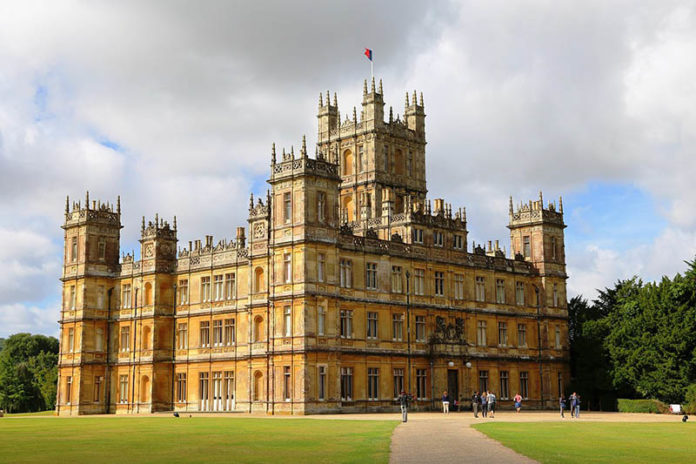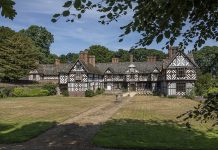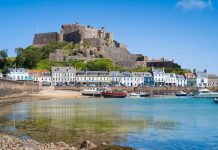The Earl of Carnarvon has welcomed cameras back into his home, Highclere Castle, for a further series
The Crawleys, Earls of Grantham since 1772, occupy the upper floors of their stately home, Downton Abbey. Below, an army of domestic staff runs their household with military precision. Among them there are those who are loyal, those who are opportunists, those who seek profit and those who pursue love and adventure. Status may be pivotal upstairs but never assume that rank is irrelevant downstairs and, while the servants are privy to many a Crawley secret, the Crawleys know little of their world. As World War I approaches, perhaps it is not just the troops who must brace themselves for battle.
It’s all in a day’s filming at Highclere Castle. Downton Abbey stars the inimitable Maggie Smith as Violet, Dowager Countess of Grantham; Hugh Bonneville (Notting Hill) as Robert, Earl of Grantham; and Elizabeth McGovern (Ragtime) as his American wife, Cora.
It flows from the pen of Oscar-winning writer Julian Fellowes (Gosford Park) and is the most expensive British TV drama ever made, costing about a million pounds an hour to film.
Mr Fellowes is pretty posh himself and – icing on the aristocratic cake – has recently earned a peerage of his own. Followed by more than 11 million viewers, Downton has been dubbed “the best thing since Brideshead Revisited.”
Small wonder then that the sumptuous Highclere Castle in Berkshire was selected as the main location for this period drama, despite the fact that the stories unravel in and around a fictitious Yorkshire estate and village.
Other locations were also used but Highclere, which has passed through multiple incarnations since the Domesday book and been home to the Caernarvon family since 1679, is the hub and heartbeat of the action.
The Real Downton Abbey: Architecture and History
Its present-day appearance is that of an exceptionally beautiful Victorian castle, deep in the Downlands of Northamptonshire and flanked on all sides by acres of spectacular parkland. Viewed across swathes of rolling pasture and Capability Brown landscape, and accessed by a sweeping approach lined with 230-year-old Cedars of Lebanon, Highclere’s exterior might be mistaken, at a cursory glance, for Westminster. Indeed, the architect, Sir Charles Barry, also designed the Houses of Parliament.
Alternatively, with its Gothic turrets and tower, it could masquerade as a grand church. The building actually stands on the site of a medieval Bishop’s palace, once inhabited by monks. Some ecclesiastical aspects survive, such as the south-east walled Monks’ Garden, the pillared Entrance Hall and the Saloon with vaulted roof and minstrel gallery. The main staircase is red carpeted and lavish, as are all the chambers, and priceless artefacts adorn every corner.
The late 18th and early 19th centuries saw Highclere remodelled as a Neoclassical Georgian mansion but no one effected a transformation as radical as Sir Barry, during the reign of the young Queen Victoria. His new and dramatic Highclere Castle, rising against the towering backdrop of Siddon Hill, dominated the rural, political and social scene.
That impact endured through the dramas of the next centuries. In 1922 the 5th Earl, with his colleague, Howard Carter, discovered the Tomb of the Boy Pharaoh, Tutankhamun, in the Valley of the Kings, in Egypt – a discovery commemorated by an exhibition in the Castle cellars. In World War I the Castle served as a hospital; in World War II it became a home for evacuees. If Highclere’s dense walls or capacious cupboards had ears, they might harbour any number of scandals or skeletons – alarmingly parallel, perhaps, to the threads of Mr Fellowes’ plots.
The Real Downton Abbey: Film Location
Highclere is currently occupied by the 8th Earl (George Reginald Oliver Molyneux Herbert) and his family, who welcomed the cast and crew of Downton into their home for several months. His lordship has his own theory as to why their estate was chosen.
“Geography! Near London, a large building (but not too large) isolated enough to avoid entanglement with neighbouring properties, Highclere has it all in terms of the Victorian and Edwardian periods – the State, Dining and Drawing rooms, the Smoking room (full of old masters), the vaulted Saloon with atrium, the glorious Library, bedrooms, little serveries with different approaches and corridors – all perfect, and offering the kind of character that render it integral to the Downton stories.
“The grounds were ideal for exteriors, with everything from rural cottages to a park for hunting scenes and gardens for an outdoor party scene in the last episode. Two crews could shoot simultaneously here. The only rooms we couldn’t offer were the kitchens, being necessary for ongoing functions and events. For any ‘downstairs’ action servants would descend our old stairs and arrive at the bottom on a studio set.”
His lordship wavered affably between “amused” and “bemused” by the Downton invasion and its inevitable effect on the household’s routine.
“We stayed in a smaller house nearby and just moved to the Castle when needed. Opening up early in the morning, I might experience the odd painful clash across cables with spiky pot plants. My naughty labradors cottoned on to the catering scenes and would dive under tables. All you could see was a frenetic tail wagging in anticipation of a morsel being thrown in their direction.”
Film technology was a steep learning curve. “Some of my emails required a degree in physics. The new high-definition cameras were sometimes bafflingly over efficient. For a simple scene where the maid opened curtains in an earlymorning shaft of dust-speckled sunlight, they had to introduce the dust by blowing particles of oil into the atmosphere. Simply reverting to a less high-tech camera was, apparently, not a solution. We did occasionally jump up and down a bit at the sight of heavy equipment swaying about on long poles, or helium-light balloons (used to avoid erecting scaffolding) looming in their own stately but errant way, so perilously close to precious objects.”
His favourite character comes as no surprise. “I’m with Hugh Bonneville’s Earl of Grantham a hundred per cent. He would have been me… sympathetic to the history of the place and rising to the challenge of keeping it all intact.”
As for Julian Fellowes, he was delighted to make use of Highclere’s stunning upstairs after it had been rejected for Gosford Park. “Majestic rooms, light, airy… overlooking luscious parkland. I have wanted to use it for ever. I love it because it is not just one more graceful, mellow Jane Austen columns-and-porticoed manor house but, thanks to Barry’s Gothic design, a valid statement about Victorian confidence and what they felt about England’s role in the world.
Furthermore, I was pleased that we were allowed to film in all the principal interiors. So often on film, once through the front door one is, annoyingly, in a completely different house. This is more organic because it’s all in a real home.”
He had some favourite areas. “The Library – beautiful books and décor, space arranged sympathetically – it has a kind of rhythm to itself… long windows looking across the grounds. ‘Inside and outside’ is something the Victorians understood better than the Georgians. Pre-19th century, you might have to go through some kind of hall to access the garden, but the Victorians just threw their doors open and let it all in… and I love the Great Hall where the monks ate centuries ago. It has since moved through Carolean, Georgian, then (as it remains today) Victorian style, parading endless Carnarvon coats of arms.”
Asked what inspired his stories and characters, Fellowes replies, “You look around. I tend to build on emotional predicaments I’ve witnessed, possibly based on people I know, but only as a kind of lifting-off point.”
The Edwardian setting splendidly accommodated the dramatic content of the story. “1912 is not that long ago,” he says. “There were cars, trains, electricity and telephones. I hope that viewers, while they may not identify with the era, might understand that these are ‘modern’ people, and therefore enjoy examining their relationships. Different classes could be friendly.
The television cliché that domestic staff were maltreated is unrealistic. There was plenty of work for those downstairs, so no one ever had to stay. But it was a time when everyone knew the rules. Any friendship was governed by the master who, unlike the servant, could dictate the degree of intimacy.”
He was tentative at first, he admits, about revisiting Gosford Park territory. “But eight hours of television versus a feature film of limited length was tempting. I read a book about American heiresses who came here and married the aristocracy in the 1880s. What happened to them? And once I’d started to imagine a character…”
So it began, and so it will continue. We may yet see Highclere becoming as publicly prominent as the film location for Brideshead Revisited, Castle Howard, in North Yorkshire. Lord Carnarvon is optimistic. “That would be lovely. We hope to display archives about Highclere staff and employees from Edwardian times and, of course, our guides will be well informed.” The castle will open for the season at Easter.
Let’s leave the last word to Maggie Smith, described by his Lordship as the Grand Lady of the period genre. She might have been speaking for everyone involved in the production when, prior to shooting a scene in Highclere, “There is nowhere,” she remarked, “I would rather be.”
Related articles
Click here to read more about Britain’s greatest castles
The best stately homes in Britain
Britain’s greatest castles in pictures






 © 2024
© 2024